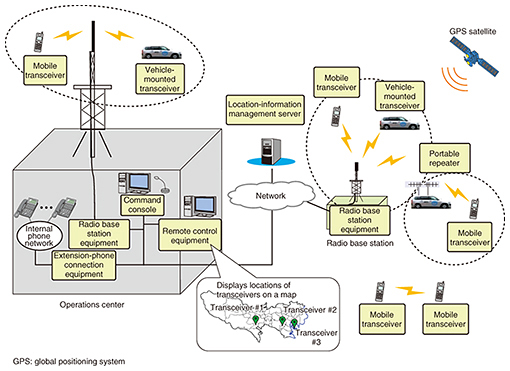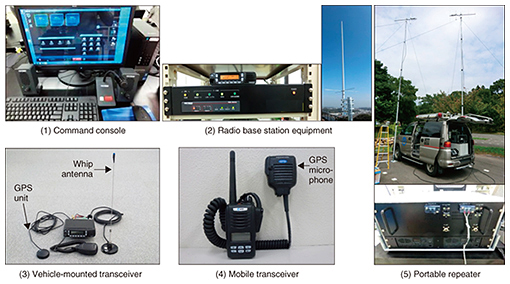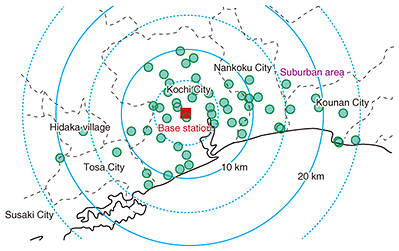 |
|||||||||||||
|
|
|||||||||||||
|
Feature Articles: Terrestrial Wireless Systems for Disaster Recovery to Provide Customer Relief Vol. 16, No. 1, pp. 47–51, Jan. 2018. https://doi.org/10.53829/ntr201801fa7 Business Radio System Providing Stable Means of Contact without Dependence on Other Carriers’ NetworksAbstractNTT Access Network Service Systems Laboratories has developed a business radio system (TZ-161A). This system uses a nationwide licensed frequency band that prevents interference with other operators, suffers no deterioration in voice quality, and receives and transmits global positioning system data. In addition, the communication channels used by the system are independent of other carriers’ networks, enabling stable communications for business operations even in the event of a wide-area disaster. Keywords: disaster recovery, business radio system, push-to-talk communication 1. IntroductionDuring the Nippon Telegraph and Telephone Public Corporation era, an analog wireless system based on push-to-talk (PTT)*1 communications in the 150-MHz band was used for the company’s internal communications. This system was further enhanced in 1991 as the TZ-151B system featuring a privacy function and data communications. With the explosive growth in the use of mobile phones thereafter, though, the use of TZ-151B for in-house communications gradually declined. However, NTT telecommunication facilities sustained an enormous amount of damage over a wide area in the Great East Japan Earthquake in 2011, and the loss of commercial power supplies and depletion of backup batteries on mobile phone base stations made it difficult to use mobile phones to convey conditions in disaster-stricken areas and provide information for restoration [1]. Against this background, NTT again recognized the importance of having a wireless means of in-house communication that was robust against natural disasters and independent of other carriers’ networks.
2. Configuration of business radio systemThe configuration of the business radio system is shown in Fig. 1. This system features radio base station equipment, mobile transceivers, vehicle-mounted transceivers, and portable repeaters as well as network-related equipment consisting of remote control equipment, a command console, a location-information management server*2, and connection equipment for extension phones.
3. Main functions and technical featuresThe main functions and technical features of the TZ-161A system are described in this section. 3.1 Voice-calling functionThis function provides communications with mobile transceivers and vehicle-mounted transceivers within the coverage area of the radio base station equipment and enables voice calling via PTT communications with the command console on the network. It also enables calling on extension phones installed inside the company via the extension-phone connection equipment. 3.2 Location-information management functionThis function enables an operator within the operations center to check where mobile transceivers and vehicle-mounted transceivers are located within the area of the radio base station. Specifically, equipping the mobile transceivers and vehicle-mounted transceivers with global positioning system (GPS) capabilities enables them to receive signals from GPS satellites, determine their own locations, and periodically transmit their location information via radio. This information is received by the radio base station equipment and then passed to the location-information management server for periodic updating of location information. Finally, this server transfers the updated information to the remote control equipment, where it is displayed as transceiver location information on a map. Here, the transmission of location information makes use of the same radio resource as voice calling, so an increase in the number of transceivers in the field can result in the transmission of a large volume of location information, putting pressure on the capacity of that radio resource. The system has a technical feature to address this issue; specifically, it incorporates a mechanism for controlling the transmission timing of location information to prevent quality degradation in voice calls and enable efficient transmission of location information [2]. 4. Appearance of TZ-161A systemThe appearance of the TZ-161A system components is shown in Fig. 2.
(1) The command console is installed where the operator is located. Selecting a radio base station displayed on the screen enables PTT communications with mobile transceivers and vehicle-mounted transceivers within the coverage area of that base station. (2) Radio base station equipment is installed inside an NTT communication building. It uses an omnidirectional or Yagi-Uda antenna*3. (3) A vehicle-mounted transceiver is installed in a construction vehicle or business vehicle. The whip antenna is equipped with a magnetic mount, making it easy to affix it to the vehicle’s body. (4) A mobile transceiver is carried around and used by personnel in the field. (A vehicle-mounted transceiver connects to a GPS unit, whereas a mobile transceiver connects to a GPS microphone to enable an effective location-information management function in addition to voice calling.) (5) A portable repeater enables the coverage area of the radio base station equipment to be extended.
5. Radio specifications and coverage areaRadio equipment specifications are listed in Table 1. This wireless system conforms to the Association of Radio Industries and Business (ARIB) Standard STD-T102 [3]. It is a narrowband digital telecommunication system using SCPC (single channel per carrier) and 4FSK (4-level frequency shift keying) as the modulation method. The radio frequency band is 160 MHz, and the channel interval is 6.25 kHz. Compared to the analog business radio system used by NTT during its public corporation era, this new system improves spectrum efficiency and accommodates three times the number of communication channels for the same bandwidth. Transmission output is 10 W for radio base station equipment and vehicle-mounted transceivers and 5 W for mobile transceivers.
In a field experiment conducted by NTT, a radio base station was installed within Kochi City in Kochi Prefecture to verify and evaluate the area of the voice-calling function. The resulting coverage area is shown in Fig. 3. Points corresponding to a clear call based on a subjective evaluation are indicated by the green circles in the figure. This system was found to cover an area extending approximately 20 km from the radio base station and encompassing urban areas as well as suburban areas with few tall buildings.
6. Deployment statusDeployment of the TZ-161A system began in 2014 by both NTT EAST and NTT WEST. As of October 2017, the system has been operating in the Tokyo Metropolis, Chiba Prefecture, Saitama Prefecture, and Shizuoka Prefecture. The plan is to expand the deployment area going forward. References
|
|||||||||||||








